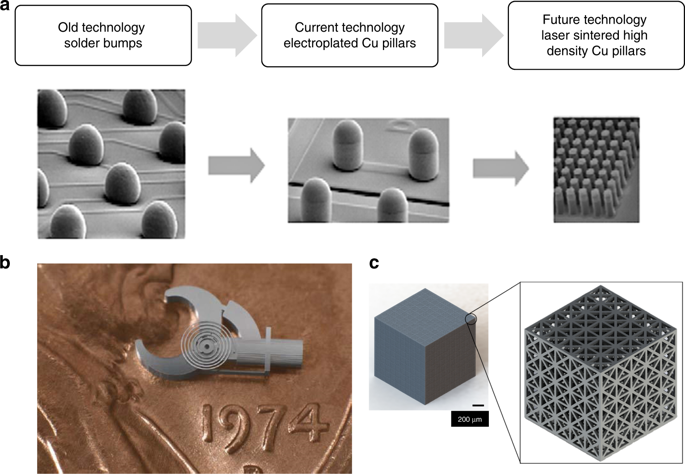Microsystems & Nanoengineering ( IF 7.3 ) Pub Date : 2019-12-30 , DOI: 10.1038/s41378-019-0116-8 Nilabh K Roy 1 , Dipankar Behera 1 , Obehi G Dibua 1 , Chee S Foong 2 , Michael A Cullinan 1

|
One of the biggest challenges in microscale additive manufacturing is the production of three-dimensional, microscale metal parts with a high enough throughput to be relevant for commercial applications. This paper presents a new microscale additive manufacturing process called microscale selective laser sintering (μ-SLS) that can produce true 3D metal parts with sub-5 μm resolution and a throughput of greater than 60 mm3/hour. In μ-SLS, a layer of metal nanoparticle ink is first coated onto a substrate using a slot die coating system. The ink is then dried to produce a uniform nanoparticle layer. Next, the substrate is precisely positioned under an optical subsystem using a set of coarse and fine nanopositioning stages. In the optical subsystem, laser light that has been patterned using a digital micromirror array is used to heat and sinter the nanoparticles into the desired patterns. This set of steps is then repeated to build up each layer of the 3D part in the μ-SLS system. Overall, this new technology offers the potential to overcome many of the current limitations in microscale additive manufacturing of metals and become an important process in microelectronics packaging applications.
中文翻译:

用于制造微电子零件的新型微尺度选择性激光烧结(μ-SLS)工艺
微型增材制造的最大挑战之一是生产具有足够高吞吐量以适合商业应用的三维微型金属零件。本文提出了一种称为微尺度选择性激光烧结 (μ-SLS) 的新型微尺度增材制造工艺,该工艺可以生产分辨率低于 5 μm 且吞吐量大于 60 mm 3 /小时的真正 3D 金属零件。在 μ-SLS 中,首先使用狭缝模头涂布系统将一层金属纳米粒子墨水涂布到基材上。然后将墨水干燥以产生均匀的纳米颗粒层。接下来,使用一组粗略和精细纳米定位台将基板精确定位在光学子系统下方。在光学子系统中,使用数字微镜阵列图案化的激光用于加热纳米颗粒并将其烧结成所需的图案。然后重复这组步骤以在 μ-SLS 系统中构建 3D 零件的每一层。总体而言,这项新技术有可能克服当前金属微型增材制造的许多限制,并成为微电子封装应用中的重要工艺。











































 京公网安备 11010802027423号
京公网安备 11010802027423号